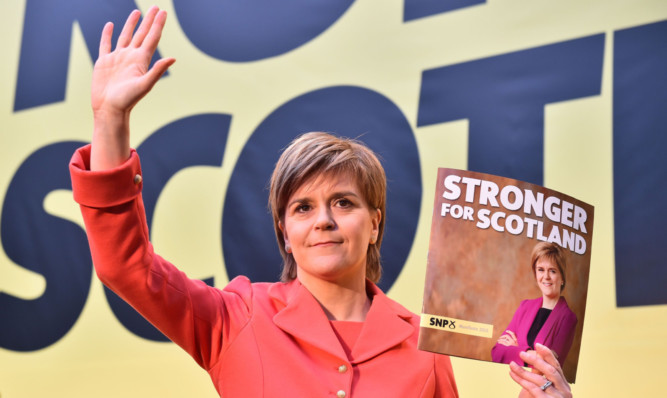Nicola Sturgeon demanded sweeping new powers for the Scottish Parliament as she outlined her vision to reverse the UK’s financial belt tightening after the general election.
The First Minister launched the SNP election manifesto with a pledge that her party would not only fight to “make Scotland stronger” but also bring about “real and positive change” for people across the UK.
However, she provided no costings when asked about the detail of the Nationalists’ central policy of full fiscal autonomy rebranded full fiscal responsibility in the document.
The Institute for Fiscal Studies says it would leave Scotland with a £7.6 billion financial shortfall, with Ms Sturgeon arguing it would take “several years” for it to be implemented.
And, despite the manifesto’s pledge to “priorities devolution of powers over employment policy, including the minimum wage, welfare, business taxes, national insurance and equality policy,” senior party sources said this would too be phased, with the likes of the state pension likely to be at the bottom of the list.
As Ms Sturgeon unveiled the manifesto at Edinburgh’s International Climbing Arena, Prime Minister David Cameron warned a Labour administration propped up by the SNP would be a “match made in hell for the British economy”.
But the First Minister said the Conservative leader’s comments were “born out of panic and desperation”, claiming that Mr Cameron was “making a huge tactical and strategic mistake” in his campaign.
The SNP manifesto makes the case for “modest” increases in public spending, resulting in “at least £140 billion extra investment across the UK, an additional £9.5 billion above the rate of inflation for the NHS by 2020/21, an increase in the minimum wage to £8.70 an hour by 2020”.
Overall, she said the SNP manifesto was “fiscally responsible” but added that it also said: “We need to reduce the deficit in a way that does not tear up the fabric of our society.”
Ms Sturgeon said the party’s manifesto “sets out our priorities for progressive change”, adding: “It is a manifesto, above all else, to end austerity. That will be our number one priority.”
Labour leader Jim Murphy claimed full fiscal autonomy would lead to public service cuts or tax rises.
He said: “This is a ‘say one thing do another’ manifesto. They claim to support a UK-wide Mansion tax at the same time as committing to cutting Scotland off from UK-wide taxes.”
Liberal Democrat Scottish Secretary Alistair Carmichael added the manifesto was short-term thinking and long-term debt.
He said: “Instead of taking the opportunity to map a route out of debt, Nicola Sturgeon is sticking with a plan to plunge the country further into it.”
